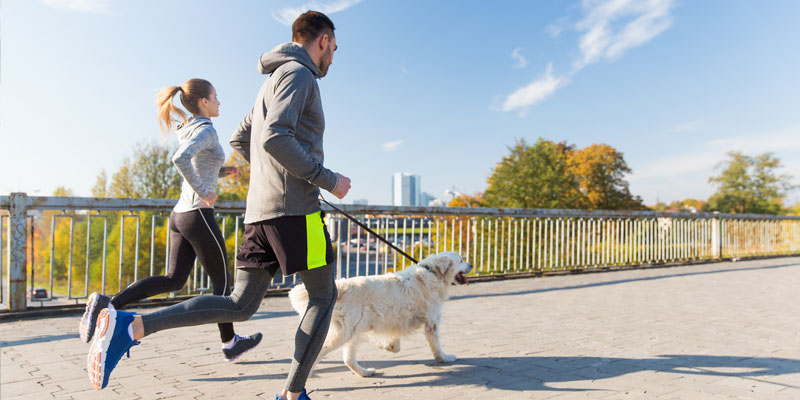More than 55 percent of dogs and 59 percent of cats were classified as overweight or obese, according to the Association for Pet Obesity Prevention (APOP). Fifty-eight percent of pet owners and 54 percent of veterinary professionals reported that they tried to help their own pet lose weight.
When asked during the survey what the “biggest challenge to exercising your dog” was, 25 percent of pet owners and 43 percent of veterinary professionals said they were “too busy.” Twenty-one percent of pet owners and 19 percent of veterinary professionals said it was due to behavior issues, while the other answer rounding out the top three was inadequate access to exercise areas.
“All animals need exercise – cats need to play, dogs need to run, even hamsters need to spin on their wheels,” according to American Humane. And thanks to COVID 19, more and more people have brought a pet into their home since March.
So, if you’re going out to exercise, it may not be the worst idea to bring your pet along with you. However, keep in mind that while exercising with your pet can be lots of fun, there are a few do’s and don’ts to be aware of.
The Do’s
Do check with your veterinarian before starting any exercise routine. It’s important to make sure that your pet is healthy enough for activity.
Do start slowly, since too much too soon can cause injury for your pet. Just like you would for your own workouts, it’s important to start with short distances and short amounts of time, then work your way up to longer workouts. Veterinarians will also advise you to pay attention to any soreness or discomfort that your pet may be experiencing and to tailor your workouts accordingly.
Do choose the time of the exercise, picking a cool time of day, such as the evening or the early morning, according to Therapy Pet. This will protect your dog from getting heat stroke and prevent skin problems caused by the harmful UV rays.
Do build strength and endurance for you and your dog by walking a mile or more every day, according to American Humane. This will allow you and your dog to burn calories, breathe fresh air and discover what’s new in the neighborhood. American Humane also says that most dogs won’t run around a fenced yard long enough to get the exercise they need, and that time together – especially active time – provides an opportunity for you and your dog to interact and establish mutual communication and a strong bond of affection.
After a mile, a 5K is a reasonable next step for most larger breeds.
Do be aware of the paws, especially on hot pavement, according to Preventative Vet. “If you put the back of your hand against the hot surface for 5-7 seconds and it’s too hot for you, then it’s too hot for your dog’s paws. It’s also wise to be aware of on-ground distractions that could injure your pup, like broken glass.
Do allow your dog to rest and/or sleep after the workout session. This will help your dog recover and be ready for the day ahead.
The Don’ts
Don’t forget the water and a treat, making sure to reward and hydrate your dog and yourself at the completion of exercise. Long Haul Trekkers also recommend a cooling vest, soaked in cold water, for longer runs.
Don’t assume that your dog will be great at exercising and understand the breed first. “Remember that not all canines are naturally born to do specific exercises such as running,” according to Therapy Pet. “For some breeds, especially pugs and bulldogs, distance running can be downright dangerous because their mechanism for processing air is different, which makes them more vulnerable to heat-related problems.” Breeds such as Golden retrievers, collies and Weimaraners make good running partners, according to Therapy Pet.
Don’t forget tick protection, especially if you and your dog will be exercising outdoors for long periods.
Don’t ignore signs of stress, as exercising with your pet in hot weather can put them at risk for heat stroke, according to True Care Veterinary Hospital. Signs of heat stroke include excessive panting, drooling, abnormally red gums and tongue color, trying to lie down, stop or seek shade, rapid or irregular heart rate, weakness and/or collapse.
Don’t work out with your puppy. According to The Kennel Club, puppies don’t need as much exercise as full-grown dogs. Also, overworking a puppy is very risky on developing bones and joints. As a rule of thumb, stick to a ratio of five minutes of exercise (at a time) per month of age until the puppy is fully grown.








